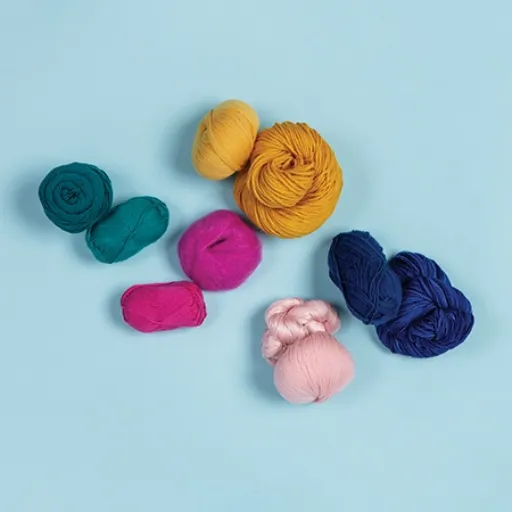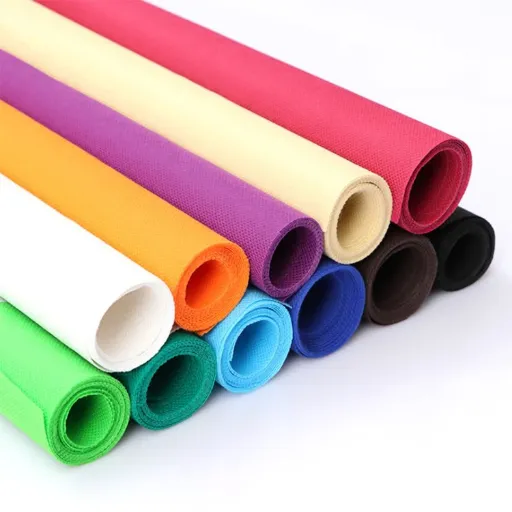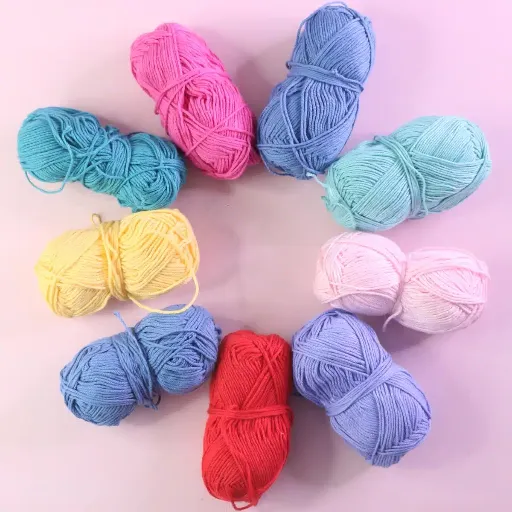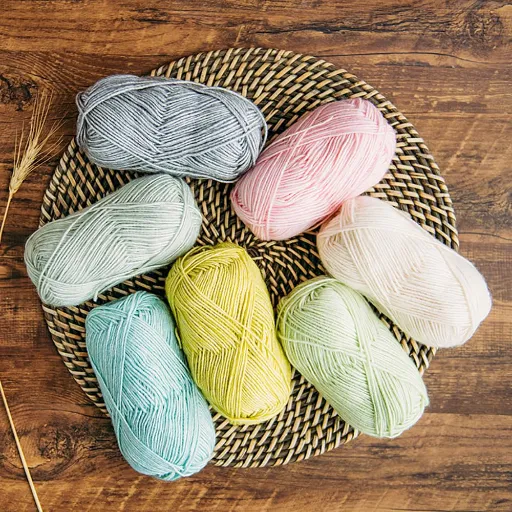Choosing the right fabric for your baby’s clothing is an important decision for any parent. Out of all the materials available, polyester is often one of the most chosen ones because of its low price, durability, and easy care. However, is polyester really the best and safest option for extremely sensitive infant skin? In this blog post, we will thoroughly analyze the good and bad sides of using polyester fabric for baby clothes. We will go through its properties, possible advantages, and disadvantages, which will help you to decide what fabric to use for your baby that will be comfortable and safe at the same time. Keep reading to learn everything about polyester, and its suitability for your family.
Understanding Polyester as a Fabric

What is Polyester?
Polyester is a man-made fabric derived from petroleum resources. The overall creation process of polyester involves a series of chemical reactions, in which ethylene glycol and terephthalic acid are combined to yield strong and flexible fibers. The fibers are then drawn into threads and eventually turned into fabrics of various qualities and types.
Among the main properties of polyester, the first one is its long-lasting quality. It does not shrink, stretch, or wrinkle, thus being a very easy-care fabric for clothing. Besides, its lightness, good shape retention, and quick drying make it very convenient for daily use. Its ability to wick away moisture also adds to the comfort of the wearer by preventing wetness and clamminess in some situations.
Nevertheless, there are a few downsides to polyester. As it is made from synthetic resources, it does not provide the same level of ventilation as the natural fibers like cotton or bamboo, which may result in discomfort during hot weather conditions. What is more, the polyester-making process consumes non-renewable resources, which is an environmental issue. A full acquaintance with these characteristics is crucial to deciding if polyester is a suitable material for your baby’s clothes.
Common Uses of Polyester in Baby Products
When it comes to baby products, polyester reigns supreme due to its durability, low cost and versatility. Clothing for babies is one of the main applications for polyester, with the most common items being onesies, pajamas, and jackets. Parents who prefer low-maintenance garments will find polyester fabrics useful since they are lightweight, wrinkle-resistant, and able to retain their shape even after multiple washes.
Polyester is not only a clothing material but is also often used in baby care items such as blankets, mats, and stroller liners. It is a useful choice for goods that are regularly used and cleaned because of its durability against stains and moisture. Moreover, polyester batts are utilized for baby bedding and stuffed toys as the filling material due to its softness and non-allergenic quality, thus, promoting comfort and safety.
The fabric is also employed in some baby carriers and diaper bags, where its strength and durability make sure that these products last for a long time. Despite the undeniable practicality of polyester, parents should still take into account issues such as ventilation and possible skin irritation when buying products for their infants. Going for blends or making sure that the material is properly lined and soft can win over the material’s functionality in favor of the baby’s comfort.
Comparison with Other Fabrics: Cotton vs. Polyester
In the cotton-polyester comparison, it is clear that each fabric has its own set of benefits that depend on the final application. Cotton is a natural fiber that attaints its reputation through its air passage, softness, and being hypoallergenic. Those attributes bring cotton to the forefront as the best fabric for infants or toddlers with skin that is easily irritated or sensitive. Moreover, its reliability to absorb moisture makes it suitable for people who live in hot areas since it prevents the body from overheating but at the same time, it is a disadvantage as it takes longer to dry and the material may shrink or wrinkle after washing.
Polyester, however, is a man-made fiber that is valued for its long-lasting quality, water-resistiveness and being easy to maintain. Polyester, unlike cotton, is very quick in drying and it is hardly ever wrinkled or shrunk which makes it a parent’s dream material when looking for low-maintenance materials. Besides that, during the process of making, polyester is, in a way, endowed with strength which guarantees that diaper bags and car seat covers and other similar items made of polyester will not only remain in good shape but will be durable as well. But at the same time, its lack of breathability might be a disadvantage, as it could hold heat and moisture next to baby soft skin, therefore, if the baby is very sensitive to heat, polyester would not be the best choice.
At the end, the decision about whether to go for cotton or polyester is made by the parents on the basis of their priorities. Cotton often feels the best if wearing comfort and gentleness on the skin are the factors under consideration, especially when it comes to products that are in direct contact with the skin. Polyester, on the other hand, is generally the better option for items that need to be durable and resistant to water and/or stains, e.g. outer garments and accessories. The combination of the two fabrics gives an ideal solution where the sweetness of cotton as well as the practicality of polyester are united. Parents should always keep the particular needs of their infants and the use of the product in mind when making a selection.
Safety of Polyester for Babies

Is Polyester Safe for Babies’ Clothing?
When used properly, polyester can be safe for babies’ clothing, but there are important factors to consider. Polyester is a synthetic fabric that is durable, lightweight, and inexpensive. It is commonly used in baby clothes because it doesn’t wrinkle, shrink, or stretch. However, it is less breathable than natural fabrics such as cotton, and this lack of breathability may lead to discomfort or overheating if the baby is in a warm place or wearing tight clothes.
In the case of babies with sensitive skin, polyester may, in some instances, cause irritation. This happens because synthetic fabrics are not as effective in wick moisture away as natural fibers, and thus, skin irritation from sweat accumulation can occur. Parents are advised to keep an eye on their child’s skin for any sign of redness or discomfort if polyester clothing is being used. If there is any sign of irritation, it is best to switch to natural, breathable fabrics like organic cotton.
In the end, wearing polyester clothing is safe as long as it is done in the right way, like in cooler places or layers with more breathable fabrics. It is very important to select high-quality polyester blends that comply with safety and non-toxic standards, especially for newborns. Besides, parents should consider the baby’s comfort, the correct fit, and the proper care of the garments to ensure their baby’s good health.
Potential Risks of Polyester
Polyester is a polymer product that is nevertheless widely accepted for its versatility and suitability for various applications. However, it can still be an issue depending on the situation or the person using it. The main problem that may arise with polyester is that it is not as breathable as, say cotton or wool. The skin may then suffer from the trapping of heat and moisture due to the lack of airflow, especially in hot and muggy places or when used by a person with sensitive skin or suffering from a condition like eczema.
The other thing that may come up with polyester is that it doesn’t have the same good odor retention properties as natural fibers. Odors now become harder to eliminate from polyester clothes, and thus, washing them more often or taking special care becomes the only option. For infants or people who have sensitive skin, the moisture and bacteria that have been retained can lead to skin infections or rashes.
Also to note is that there are some polyester fabrics that are treated with chemicals to improve their performance like durability, water resistance, and wrinkle resistance during the manufacturing process. These chemicals are regarded as being relatively safe for the average consumer, but at the same time, they can produce volatile organic compounds (VOCs) or other similar substances. Penned in by such a situation, a person may suffer allergic reactions or irritations if he or she is particularly sensitive. Hence, it is advisable to wear clothes made from the best quality and non-toxic polyester blends and to adhere to proper washing and caring instructions in order to reduce such risks.
Harmful Chemicals in Polyester Fabric
Polyester fabric can contain harmful chemicals that pose potential health risks. During production, chemicals such as antimony, a heavy metal catalyst, are often used. Traces of antimony can remain in the finished product and may be absorbed through the skin or inhaled, especially when polyester is heated or worn for prolonged periods. Additionally, dyes and finishing agents used on polyester garments can release substances like formaldehyde, which may lead to skin irritation or respiratory issues for sensitive individuals.
Another concern with polyester is the release of microplastics during washing. These tiny plastic particles shed from synthetic fibers enter waterways, potentially affecting marine life and ecosystems. Microplastic contamination has even been found in the food chain, indirectly raising health concerns for humans over long-term exposure.
To mitigate the risks associated with polyester fabrics, consumers can opt for well-ventilated storage, limit the use of heat on synthetic clothing, and launder polyester garments with filters designed to capture microplastics. Where possible, choosing eco-friendlier fabric alternatives or certified non-toxic polyester products can also significantly reduce exposure to associated harmful chemicals. Proper care and mindfulness can help minimize these risks while still benefiting from polyester’s durability and affordability.
Comfort and Breathability

How Polyester Affects Baby Comfort
Polyester is one of those materials that can simultaneously affect a baby’s comfort positively and negatively. To start, polyester is tough, long-lasting, and cost-effective fabric, but still, it cannot compete with the natural cotton when it comes to breathability. Polyester retains heat and moisture, which might lead to the baby getting hot, sweaty, or even uncomfortable, particularly in hot climates. Such situations can aggravate skin sensitivity and rashes, especially if the fabric in question is rubbing against the baby’s ultra-sensitive skin.
Furthermore, we must point out the fact that polyester has a very poor moisture absorption capacity. Babies are known to sweat, drool, or spill from time to time, and the inability of polyester to absorb moisture results in the skin being wet for a longer time. That might be the reason for the baby feeling uncomfortable and even having skin problems such as chafing or diaper-area irritation.
When it comes to comfort, parents might choose to dress their children in clothes made of natural or blended fibers as those will be more capable of providing better airflow and moisture absorption. In case polyester is worn, it would be a good idea to make sure the fit is right and that it is layered with breathable fabrics so that one does not suffer from the other. Choosing the fabrics according to the baby’s skin sensitivity and the weather conditions is the main thing that will help keep the little one comfortable and healthy.
Breathability of Polyester vs. Natural Fabrics
In the comparison of the breathability of polyester to that of natural fabrics such as cotton or linen, polyester ranks low among the natural fabrics. The main reason behind this is that natural fibers allow the air to circulate and at the same time, they can absorb the moisture which helps to keep the skin cool and dry in hot conditions. Hence, natural fabrics are the best option for people living in hot and humid areas who want to maintain their comfort level.
On the contrary, polyester, being a synthetic material, has tenacity and resistance to creasing among its foremost characteristics. But, its limited breathability is one of its drawbacks as it does not absorb sweat as easily as the natural fibers. This scenario can lead to sweat trapping and thus, leading to discomfort which is usually the case during physical activities or in the hot weather. To overcome this problem, some manufacturers utilize advanced construction for their polyester products or blending with other materials so as to improve the ventilation, though the products might still not reach the breathing level of the natural fabrics.
In the end, the decision to go for either polyester or natural fabrics should be based on one’s personal requirements and the environmental conditions prevailing in one’s location. For the daily dressing in the hot places, the use of natural fabrics is not only for comfort but also for breathing reason. Polyester can still be selected for having the specific performance in activewear and strength but while passing, it with breathable fabrics can help in softening its limitations. The key to making an informed choice is to adjust fabric selection prioritizing comfort and suitability.
Heat Regulation in Polyester Clothing
Polyester ranks among synthetic materials because of its strong and flexible characteristics. However, the heat regulation properties of polyester depend on the fiber construction and usage mostly. Although polyester is not a fabric with high breathability, recent developments in technology have made it possible to produce moisture-wicking and lightweight versions of the fabric, which are now suitable for warm-weather usage. Certain areas of the body are designed to be sweat-proof so that the sweat gets evaporated quickly thus making the wearer cooler.
The performance-driven designs are one of the ways in which polyester regulates heat more effectively, and these designs often have micro-perforations, and use blended fibers as well. Merging polyester with hemp or another breathable natural fabric like cotton helps airflow and thus comfort during hot days. Such blends results in less heat being held and yet the strengths and toughness of the fabric remain intact.
However, it is good to bear in mind that besides the factors of fabric and construction, temperature, activity level, and humidity are also factors that determine how effective polyester is in heat control. When it comes to warm places choosing polyester clothes that have moisture-wicking abilities and are loose-fitting should be your biggest priority as they permit maximum airflow and hence cooling. By caring for them in the right way and choosing wisely, polyester can be a heat regulating choice that is suitable for anywhere.
Polyester and Sensitive Skin

Understanding Sensitive Skin in Babies
Sensitive skin in babies is something that most parents and caregivers worry about a lot. Because of the infant’s skin being thinner and less developed than in adults, infants are more easily affected by skin irritation, dryness and reactions to various factors such as environmental conditions, fabrics, detergents, and personal care products. The undeveloped natural barrier of their skin causes the baby to be very sensitive, thus requiring it to be given special handling and care with great gentleness.
Polyester fabrics, which are very common, can sometimes trigger irritation in very sensitive skin if the support they give in terms of air circulation is not adequate or if they keep the baby’s skin in contact with moisture. The heat and moisture that are created might lead to rashes or discomfort. For babies that have sensitive skin, it is a must to select fabrics that are very soft, highly breathable, and can absorb moisture well. If polyester is the choice, then choosing a lightweight one and mixing it with other softer and skin-friendly materials will help to minimize any possible irritation.
For the sake of sensitive skin, all baby clothing should be washed only with mild, fragrance-free detergents that are meant for delicate skin. Also, avoid harsh chemicals and strong scents in both the fabrics and skincare products. Moreover, it is wise to often check the baby’s skin and to see a pediatrician if there are any rashes or irritation that last a while, as that will help keep the skin in the best condition. Making these precautions will mean that the babies with sensitive skin can be comfortable and safe.
Polyester Sensitivities and Allergies
Polyester sensitivities and allergies might be perceived as skin irritation or discomfort as polyester is a non-natural material that might prevent skin from breathing. The skin can become red, itchy, or even blistered because of the trapping of heat, moisture, and bacteria against it due to the non-breathability. The skin irritation might be aggravated if the person is sensitive to the chemicals used in the production of polyester fabrics.
If you are sensitive to polyester, it is advisable not to wear or have anything made of polyester, particularly on the body parts that sweat or friction gets. Natural fibers such as cotton or linen are the better choices because they are soft and breathable. In addition to this, it is also good practice to wash all new fabrics thoroughly before using them to get rid of any potential irritants that may have come from the manufacturing process.
Dermatologist consultation is the next step if the symptoms of irritation do not go away or become worse. They might discover what exactly is causing the sensitivity and suggest such treatments as topical creams or antihistamines. Knowing one’s own sensitivities and wearing skin-friendly fabrics can go a long way towards minimizing discomfort and promoting skin health.
Choosing the Right Fabric for Sensitive Skin
Choosing the right fabric for sensitive skin is a crucial part of the process to avoid making the skin irritated and to keep it comfortable. The use of natural fabrics such as cotton and silk is strongly advised because of their softness, breathability, and low potential to cause itching or rashes. For this reason, the air-nonimpeding characteristic of cotton leads to the reduction of moisture hence skin irritation coming from that moisture is less likely to occur. The smoothness of silk on the other hand, as well as the pleasing factor, may be a physical barrier to sensitive areas while giving the skin the needed protection of the barrier against friction.
As for the synthetics, it is better off not to use them at all the likes of polyester, nylon, or spandex, since these materials tend to trap heat and moisture thus aggravating skin sensitivity. Besides, using the synthetics that have been treated with chemicals in the manufacturing process is surely making sensitive skin more irritable. Going for untreated or organic natural fibers will, however, guarantee fewer chemical residues and hence less discomfort.
Labels that denote hypoallergenic, chemical-free, and gentle fabrics should be looked for when buying clothes for sensitive skin. Loose-fitting clothing is also a good option as it prevents unnecessary rubbing and lets the skin breathe in a comfortable way. Aiming for such fabrics, taking into account the unique needs of your skin, you will have long-lasting comfort as well as making your skin healthier overall.
Alternatives to Polyester

Bamboo Baby Clothes: A Natural Alternative
Bamboo baby clothes can be a wonderful choice to replace polyester and other synthetic fabrics, primarily for the very sensitive and soft baby skin. Bamboo fabric’s natural softness and good air flow property do help in controlling temperature and keeping babies in their comfort zone regardless of the conditions. Its silky feel compounds the irritation, hence making it one of the most admired children’s clothing material especially for those with skin sensitivity or rashes.
One more major benefit of bamboo clothing is the fact that moisture can be transferred away from the skin. Bamboo fibres can take up moisture many times better than some of the traditional fabrics & even cotton, so the baby’s skin stays healthy and dry. This prevents the discomfort and irritation of skin caused by dampness. Moreover, bamboo fabric has natural antibacterial qualities that may help in getting rid of the odor and stopping the bacteria from growing thus keeping hygiene good.
Moreover, last but not least, bamboo is a newcomer in the eco-friendly textiles world too. It is a very fast-growing crop that consumes less water and no or very few pesticides compared to other plants grown for fabric. So, bamboo baby clothes that bring comfort and health to your child’s skin would at the same time support the environmentally friendly practices which are less harmful to the planet.
Benefits of Organic Cotton for Baby Clothing
Baby clothes made from organic cotton are a win-win for both comfort and planet, as organic cotton has many benefits. To start with, it is farmed with no harmful chemicals at all such as synthetic pesticides or fertilizers. As a result, organic cotton is so much safer for a baby’s fragile skin and irritation or allergy are greatly diminished. Newborns usually have very tender skin and cotton, as their material, is smooth and soft and guarantees them comfort the whole day through.
Breathability is another important property of organic cotton that fewer people know about. The fabric allows air to come in and out without any barrier, thus eliminating the possibility of heat build-up and helping to keep the body temperature of a baby stable. In addition, it absorbs moisture pretty well which means that it can take in skin sweat completely. All these qualities put together make organic cotton the best choice for babies in any season, as they are safe and content whether the temperature is hot or cold.
On top of that, organic cotton has an earth-friendly aspect. No toxic chemicals are released into the environment which is the biggest benefit of this particular growing process. Chemical pollution can occur when the soil and water are contaminated with the fertilizers and pesticides that are normally used in the case of conventional farming methods. Also, the watershed is saved as organic cotton farming practices take up less water than their conventional counterparts. Parents buying organic cotton baby clothes not only give their offspring a top-notch product but also back-up the earth’s future with more sustainable and eco-friendly practices.
When to Choose Polyester vs. Alternatives
Polyester is a strong and multi-purpose material that can be used in a lot of areas, especially when strength, low-cost and no-maintenance are the key factors. It is resistant to wrinkles, shrinking and stretching which makes it perfect for everyday wear, sportswear, and home textiles such as curtains or bedding. Moreover, its fast-drying feature also makes it appropriate for outdoor equipment or clothes intended for wet or humid conditions.
Nevertheless, when comfort and sustainability are strongholds, polyester alternatives step into the spotlight. Natural fibers such as cotton, wool or linen are often more breathable and thus, more comfortable against the skin. This feature makes them preferable for delicate skin and warm weather. Furthermore, natural fabrics are compostable and their environmental effect during production and disposal is less than that of polyester which, being synthetic and petroleum-based, is slow to decompose. When choosing your fabrics based on environmental friendliness or when looking for a softer and more natural feel, always pick the natural alternatives.
The decision, however, is finally yours based on the application and the associated values. If a strong, low-cost and performance under difficult conditions are your top priorities then polyester will win your heart. But, if you are someone who prioritizes sustainability, comfort and less environmental impact, then natural or organic fabrics will be your best choice. Weighing these factors will lead to an informed and effective choice.
Frequently Asked Questions (FAQ)
Q: What are the benefits of using polyester for baby items?
A: Polyester is a preferred fabric in various baby products due to its resistance to wear and durability. It is a practical option for baby apparel and bedding since it is easy to wash and dries fast. Some parents also deem polyester garments for infants to be quite pleasant as they are smooth on the skin and not irritating.
Q: Is polyester safe for babies?
A: Polyester, in general, is safe for babies and can be used in clothes as well as bedding. It is, however, important to use fabrics of the best quality, which are guaranteed to be free from toxic substances and flame retardants. Always read labels to confirm that the polyester used is suitable for the most delicate baby skin.
Q: Can polyester cause skin irritation in babies?
A: Despite its popularity, the synthetic fabric can be the cause of skin problems in some babies who are especially sensitive. If your little one has had a rough time with synthetic materials like polyester, you should consider organic cotton as a kinder and softer alternative for their skin.
Q: How does polyester compare to natural fabrics for baby clothing?
A: Polyester is tougher than various natural fabrics but on the downside, it does not allow perspiration to evaporate as easily. Baby-friendly fabrics like organic cotton provide good ventilation which prevents skin from getting sweaty hence they are good for babies. On the other hand, polyester can be produced from recycled plastic making it an environment-friendly option if done right.
Q: Are there any risks associated with using polyester for baby blankets?
A: It would be best to choose blankets made of wholesale polyester or soft fabrics preferably that are recycled and tagged as safe for babies since blankets made of polyester are often comfortable and safe for babies.
Q: What types of polyester fabrics are best for babies?
A: For baby items made from polyester, soft woven or knit fabrics that are machinable or finished would be the hands-down best. Recycled polyester can also be a safer choice, as it is often produced with fewer chemicals.
Q: Can polyester help reduce the risks of allergies in babies?
A: Polyester is considered hypoallergenic and, as a result, the incidence of allergy can’t be totally ruled out, especially in common cases like that of babies. Still, each baby reacts differently; some can have an allergic reaction to synthetic fibers. What’s necessary is that observing your baby’s response towards polyester items must be done to guarantee their comfort and safety.
Q: What should I consider when choosing polyester clothing for my baby?
A: When it comes to selecting materials for your baby’s clothing, you need to take into account the breathability, softness, and potential additives associated with the fabric. You should specifically look for polyester that is both safe for babies and free from harmful chemicals. Besides, it should be cozy and non-irritating for babies throughout the day.
Q: Is recycled polyester a good option for baby items?
A: Recycled polyester is the right choice for baby items since it comes from the recycling of plastics that would otherwise end up in landfills, thus minimizing the already small environmental impact.
References
-
Cuddle Sprouts – Is Polyester Safe for Babies? – Discusses the safety of polyester for babies, highlighting its durability but noting concerns for sensitive skin.
-
AU Baby Shop – The Truth About Polyester – Explores the potential risks of polyester, including its chemical composition and effects on health.
-
Treehouse Kids – The Hidden Risks of Polyester Clothing for Kids – Highlights studies showing how polyester affects skin temperature and moisture, which may impact comfort.
-
Autumn Moon Kids Clothing – Is Polyester A Safe Fabric for Babies? – Examines the pros and cons of polyester for baby clothing and bedding, especially for sensitive skin.
-
Woolino – Choosing The Best Fabric For Baby Clothes – Discusses polyester’s practicality for baby clothes while noting its limitations for sensitive skin and warmer climates.




















